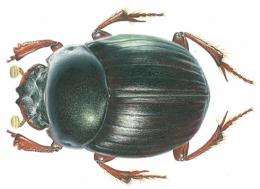Dung beetle named after Darwin

A dung beetle from Costa Rica has been named after Charles Darwin and the Darwin Initiative. It was discovered during a Natural History Museum led expedition.
The beetle, named Canthidium (Eucanthidium) darwini, was discovered in a remote and unexplored UNESCO World Heritage Site in the Talamanca Mountains as part of a Natural History Museum led project.
It was found on one of 7 expeditions to the area that were funded by the UK government‘s Darwin Initiative, which aims to assist biodiversity conservation in some of the world’s poorest countries.
The naming is timely, as this year has seen many anniversaries of the great biologist; the 150th year since his ground-breaking publication On the Origin of Species, the 200th year since Darwin’s birth and nationwide events are taking place in 2008-2009 as part of Darwin200.
The expeditions were led jointly by the Natural History Museum, INBio, and Panama's national authority for the environment ANAM. The aim was to produce tools for the conservation of an important area of the world's biodiversity.
Museum biodiversity expert Alex Monro led the expedition that discovered the beetle. ‘These expeditions were very tough,’ says Monro. ‘This particular one lasted 3 weeks, camping and hiking and using baited traps set along transect lines (sample points).’
There are about 180 dung beetle species in Costa Rica and Canthidium darwini is one of 68 species collected as part of the project, 2 of which are new to science.
‘At 4mm in length this beetle is relatively small,’ says Monro. ‘Angel Solís, expert for this group of beetles in Costa Rica and Panama, says that it appears to be most closely related to a species the other side of the mountain on the Pacific coast.’
During the 7 trips, more than 30 previously unknown species of beetle, amphibian and plant were discovered.
Dung beetles have a crucial role in nature as they consume waste such as dung and decaying flesh (carrion). They bury the waste in the ground and so contribute to soil fertility and structure.
Since they feed on mammal dung, bird droppings and their carcasses, and are relatively specialised in the range of food that they consume, dung beetle diversity can be an indicator of the density and diversity of mammals and birds in the area.
Provided by American Museum of Natural History (news : web)

















